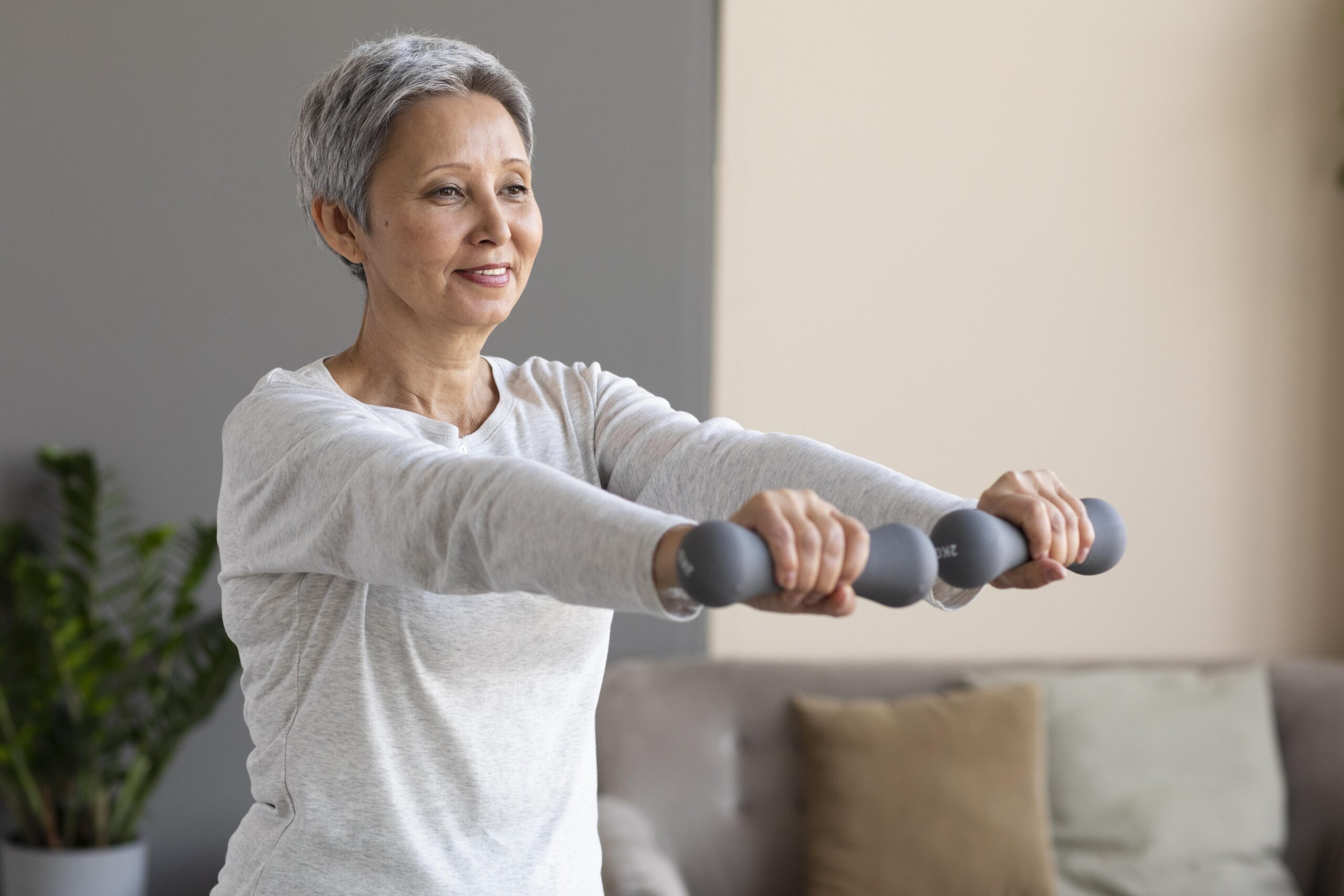Physiological aging involves progressive, regressive, and irreversible changes in the body's tissues and organs, influenced by genetic factors and coexisting diseases, lifestyle, and environmental factors. The body can maintain balance and achieve successful aging by optimizing these factors.
Aging is a complex process that should be considered from biological, psychological, and socio-social perspectives. Biologically, physiological aging involves physicochemical changes in cells, e.g., atrophy, degeneration, apoptosis, and the deposition of lipofuscin and amyloid. Metabolism slows down, and the body's ability to self-regulate, adapt, and regenerate is impaired. Despite these changes, homeostasis is maintained in older people, but over time it narrows.
As the aging process progresses, a senior's physical fitness and mobility deteriorate. On the mental level, there is a decrease in psychophysical activity and, to a lesser extent, hyperactivity, leading to mental hypersensitivity. Non-reproducing nerve cells die (apoptosis) or become damaged (even though they do not lose telomeres). The level of neurotransmitters decreases, and fibrillary degeneration increases. Dementia, including Alzheimer's disease, Parkinson's disease, and depression, may develop. Character traits become more severe, and flaws become more apparent. The attitude to life becomes “stiffened”.
The possibility of interpersonal contact decreases, there are fewer friends, the phenomenon of the “empty nest” occurs (children become independent and leave the family home), and the death of a spouse and family members. It is necessary to prepare for life in retirement in advance through a healthy lifestyle, rational nutrition, physical activity, and screening tests for chronic diseases. Emotional balance, life satisfaction, maintaining family ties, staying married, maintaining friendships, developing hobbies, and securing the autonomy of one's life are significant factors of functional longevity.

Changes occur in our cells as a result of aging![]() . The stage when the body is prepared to meet the goals of procreation ends. Old age closes this phase. If every change brings us closer to old age, then old age begins much earlier than we imagine.
. The stage when the body is prepared to meet the goals of procreation ends. Old age closes this phase. If every change brings us closer to old age, then old age begins much earlier than we imagine.
Over the years, eyesight deteriorates, objects become blurred or lose their sharpness, and small prints become invisible. Seniors have problems seeing things up close (they become farsighted), and a significant group develops cataracts. Every third person over the age of 65 notices hearing problems. Seniors also complain about deteriorating their ability to recognize smells and tastes![]() .
.
Wrinkles![]() appear on the face much earlier than in old age. Their development is influenced by facial expression, loss of subcutaneous fat layer, and decreasing skin elasticity. This is because in seniors, metabolism decreases, older cells are replaced by new ones more slowly, and all wounds heal more slowly. On the skin of people over seven, there may be spots of darker pigment and so-called age spots (discolorations).
appear on the face much earlier than in old age. Their development is influenced by facial expression, loss of subcutaneous fat layer, and decreasing skin elasticity. This is because in seniors, metabolism decreases, older cells are replaced by new ones more slowly, and all wounds heal more slowly. On the skin of people over seven, there may be spots of darker pigment and so-called age spots (discolorations).
Previously beautiful, shiny hair turns grey![]() and dull after 60 years. Melanocytes, responsible for hair color, cease to fulfill their functions and die over time. The efficiency of hair follicles also decreases. Hair does not regenerate as quickly as in youth; instead, it becomes thin and brittle.
and dull after 60 years. Melanocytes, responsible for hair color, cease to fulfill their functions and die over time. The efficiency of hair follicles also decreases. Hair does not regenerate as quickly as in youth; instead, it becomes thin and brittle.
Older people lose hair on their arms and legs, but hair can appear in other uncomfortable places. In men, stiff and coarse hair can be noticed in the ears, eyebrows, or nose. Women, on the other hand, complain about hair appearing on the chin and upper lip.
As people age, their skeletal system![]() becomes more vulnerable to injuries and fractures. Bones undergo demineralization, leading to a decrease in mass. After 60, bones can become as much as 8% lighter, with men experiencing a 3% deviation from the norm. Consequently, a common issue among older adults is a femoral neck fracture.
becomes more vulnerable to injuries and fractures. Bones undergo demineralization, leading to a decrease in mass. After 60, bones can become as much as 8% lighter, with men experiencing a 3% deviation from the norm. Consequently, a common issue among older adults is a femoral neck fracture.
The circulatory system![]() ages first. The vessels that supply blood to the heart become less elastic over the years. They are often clogged with cholesterol deposits. In such cases, the heart must work harder to pump the same amount of blood. Increased heart work also means cell damage and a greater demand for oxygen by the body.
ages first. The vessels that supply blood to the heart become less elastic over the years. They are often clogged with cholesterol deposits. In such cases, the heart must work harder to pump the same amount of blood. Increased heart work also means cell damage and a greater demand for oxygen by the body.
The intestinal peristalsis is significantly weakened. Smaller digestive juices are also produced, contributing to frequently occurring obstructions.
In the case of the kidneys![]() , both their size and efficiency decrease. As a result, the blood is less cleansed of harmful substances.
, both their size and efficiency decrease. As a result, the blood is less cleansed of harmful substances.
Sex hormones play a huge role, especially in women's lives. With their decline in production, the ability to have children, i.e., puberty, ends. However, the changes do not only concern the reproductive system; they encompass the entire female body![]() .
.
And so, women's skin becomes more flaccid, breasts become saggy, and fat is deposited in the waist, arms, and thighs. Changes in the secretion of hormones in men are not as severe for their reproductive system. A man![]() can father a child even after the age of 60.
can father a child even after the age of 60.
To stay healthy into old age, you should follow the proven principles of a healthy lifestyle:
The recommendations for proper nutrition require compliance with three basic principles: variety in the selection of products and dishes, regularity of meals, and balancing the energy balance, i.e., the energy value of the food consumed in comparison with the physical activity undertaken. Seniors forget to follow these principles for various reasons.
Meals are not always eaten regularly, sometimes their number is too small. It also happens that a hot meal does not appear in the daily diet at all. Prepared dishes are not very varied, and meals are often eaten in a crushed form (paste, pulp), which may result from missing teeth or improperly selected dentures. Some elderly people avoid products that are difficult to chew and choose dishes of low nutritional value (“dishes prepared for several days” or reheated).

The choice of technological processing in the preparation of dishes is also significant. Reduced digestive enzyme secretion makes this process more efficient when consuming products cooked in water and steam and stewed without fat in foil or parchment. Elderly people are significantly more likely to suffer from food infections resulting from consuming improperly prepared and stored food. The decreased feeling of thirst that accompanies the body's aging process causes a constant deficiency of fluids in everyday food, which can lead to dangerous dehydration.
The body's basic metabolic rate and energy demand decrease with age. This is indirectly related to a decrease in lean body mass and a simultaneous increase in the share of adipose tissue. The recommended energy demand for women over 65 years of age leading a low-active lifestyle is about 1750 kcal/day, and for men 1950 kcal/day.
Assessment and early diagnosis of malnutrition![]() are particularly important for seniors. Malnutrition among this group of people is often a consequence of insufficient coverage of energy requirements and disorders of the digestion and absorption of nutrients, which leads to protein-energy deficiencies and macro- and micronutrient deficiencies.
are particularly important for seniors. Malnutrition among this group of people is often a consequence of insufficient coverage of energy requirements and disorders of the digestion and absorption of nutrients, which leads to protein-energy deficiencies and macro- and micronutrient deficiencies.
Malnutrition significantly worsens the quality of life of seniors. It negatively affects both their functional status (e.g., the ability to eat independently, use the toilet, and maintain hygiene) and their well-being and psychosocial functioning (adaptability, commitment, and initiative). Preventing malnutrition is not an easy task because the elderly population is very diverse, and disease processes often accompany physiological changes in the aging process.
The most common risk factors for malnutrition in the elderly include:
As a result of the aging process, body composition changes occur, which are manifested by the loss of lean body mass, a decrease in bone mineral mass, and an increase in the content of adipose tissue. These changes may make it difficult for older people to engage in physical activity.
An important factor influencing the nutritional status of seniors is the deterioration of the functioning of the digestive tract. These changes include, among others, reduced salivary secretion and digestive enzymes, atrophic changes in the mucous membrane, and reduced muscle mass, which contributes, among others, to slower intestinal motility and problems with constipation. In addition, in older people, the liver mass decreases and the secretory capacity of the pancreas is impaired, leading to digestive problems manifested by diarrhea.
The efficiency of motor functions![]() declines visibly with age due to various changes, including decreased collagen elasticity, muscle and joint wear, decreased mobility, muscle and bone mass loss, and vitamin D deficiency. Vitamin D plays a crucial role in preventing falls and related consequences. Frailty syndrome represents a transitional state between preserved fitness and impending disability, regardless of co-existing diseases or obesity. This syndrome is diagnosed when at least 3 of the 5 following factors:
declines visibly with age due to various changes, including decreased collagen elasticity, muscle and joint wear, decreased mobility, muscle and bone mass loss, and vitamin D deficiency. Vitamin D plays a crucial role in preventing falls and related consequences. Frailty syndrome represents a transitional state between preserved fitness and impending disability, regardless of co-existing diseases or obesity. This syndrome is diagnosed when at least 3 of the 5 following factors:
Such a condition requires careful observation because it can quickly turn into increasing disability. In people with frailty syndrome, decompensation of the efficiency of individual organs and the entire body occurs.
Regular physical activity in old age can prevent health problems, protect against infections and cancer, prevent obesity and diabetes, and improve mental well-being. It also helps maintain balance, prevents falls, and reduces the need for painkillers. The World Health Organization (WHO![]() ) has developed a program of minimal physical activity for older people:
) has developed a program of minimal physical activity for older people:
Exercises should be continued systematically and long-term, choosing the appropriate forms. Physical activity with moderate oxygen consumption includes walking, dancing, gardening, housework, hunting, picking mushrooms and berries in the forest, playing and having fun with children, walking the dog, painting, and lifting 20 kg. High-intensity efforts include running, uphill walking, fast cycling, fast swimming, sports games (ball games), snow removal, digging, and lifting more than 20 kg.

The increase in life expectancy has led to a rise in the period of old age and illness. It is worth preventing diseases; if they do occur, it is important to recognize them early and treat them effectively. For this purpose, Seniors should avoid polypharmacy due to potential complications. When treating seniors, it's important to use proven and effective drugs, start with small doses, and gradually increase to an effective dose.
Treatment
Sources
https://www.ncbi.nlm.nih.gov/books/NBK10041/
https://www.ncbi.nlm.nih.gov/pmc/articles/PMC2579627/
https://www.ncbi.nlm.nih.gov/pmc/articles/PMC4278179/
https://www.nia.nih.gov/health/skin-care/skin-care-and-aging
https://www.sciencedirect.com/science/article/pii/S1568163723001368
https://www.ncbi.nlm.nih.gov/pmc/articles/PMC9179169/
https://www.ncbi.nlm.nih.gov/pmc/articles/PMC10389818/
https://www.ncbi.nlm.nih.gov/pmc/articles/PMC7595250/
https://www.ncbi.nlm.nih.gov/pmc/articles/PMC5683335/
https://www.ncbi.nlm.nih.gov/books/NBK278998/
https://www.nia.nih.gov/health/healthy-aging/tips-boost-your-health-you-age
https://www.nia.nih.gov/health/healthy-aging/what-do-we-know-about-healthy-aging
https://www.ncbi.nlm.nih.gov/pmc/articles/PMC8399049/
https://www.ncbi.nlm.nih.gov/pmc/articles/PMC3776533/
https://www.ncbi.nlm.nih.gov/pmc/articles/PMC7719906/